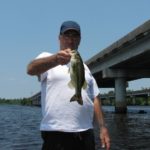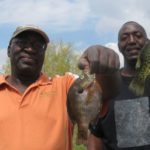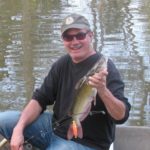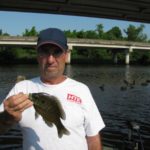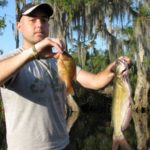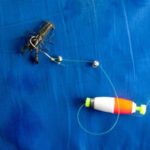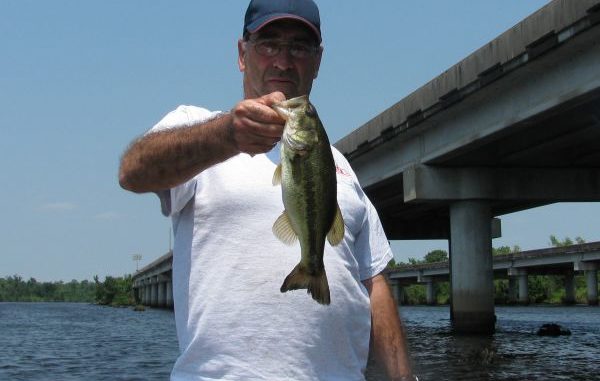
If the weather has played havoc on your supply of fish, there’s an almost-guaranteed supply along old Highway 51 that runs through the Manchac Swamp.
Only the torches and pitchforks were missing. The frowns, the yells, the shaking fists were all there. In brief, the mob was outraged — scandalized!
And poor Trisha didn’t have a clue. She just stood there, holding up the bag — but with that look of a deer caught in a head ….
Whoops — forgive me. That’s not a good figure of speech to use in Louisiana Sportsman.
Maybe it’s just me, but our deer rarely seem to get caught in headlights. And if they briefly do, they don’t sit there staring back stupidly. They’re too smart, too cagey — like our politicians.
This ain’t Pennsylvania, Wisconsin or Texas.
At any rate, poor Trish didn’t know what to make of the enraged mob surrounding her and her uplifted bag of frozen tilapia fillets.
“I gotta plan!” she had squealed triumphantly while hoisting the bag of frozen fillets. “Mega fish fry along with the crawfish boil tomorrow after all!”
The crawfish boil at Doc’s was a Memorial Day tradition. The last few years we started adding fried fish to the extravaganza. There’s something about a second course of hearty fried seafood that really hits the spot after a first course of boiled seafood. They really go great together.
But lately we’d all been dipping heavily into our own fish caches at home. Plus, the thundershowers (as usual this time of year) seemed to schedule themselves precisely for the week-end, knocking out many of our fishing trips. Then, when we finally managed to pull one off, the high river made coastal fishing in our usual areas kinda “slow.”
In brief, we’d barely managed to scrape up three little baggies of fillets for the expected crowd of 30 or so.
Trisha, bless her heart, thought she’d hit upon a solution.
“I wouldn’t feed that stuff to my cat!” Artie grimaced as he clicked the Stones’ Hot Rocks into Doc’s state-of-the-art boom box.
“Me either! No way!” came a chorus of agreement from the gang, just as the first notes of Gimme Shelter kicked in.
“But it’s the thought that counts!” Pelayo added diplomatically, while walking over to the crestfallen Trisha, wrapping his arm around her bare shoulder and smiling widely. Then he handed her a fresh glass of wine with his other hand.
This gesture seemed to help much more than the hug and smile.
“Fifty-one Canal” Pelayo winked as he paused over me on the way back to the bar. “Our mission — should we decide to accept it — is to feed the gang with fried fish on Monday. I’ve been driving that highway a lot lately. The bank fisherman doing real good on the bream, goggle-eye, green trout, even a few sac-a-lait. And as we well know by now, if those glamour fish shut down on us, there’s always a plan B.
“Remember: We’re on a freshwater meat haul here. We ain’t bringing home any gar or choupique — but we’ll load da box with everything else in the area. The channel cats, remember, are usually spawning in that area this time of year. Maaaw-ket bait or crawfish under corks around the bridge pilings — has that ever failed us?”
I frowned and pursed my lips for effect, but he had a point. Being that this area is sandwiched between two huge tidal bodies (Lakes Pontchartrain and Maurepas), tides and water levels (low and clear, good; high and dirty, bad) can really play havoc with the fishing.
But that’s mostly with the finicky glamour species.
You put a nice chunk of smelly shrimp or crawfish near a spawning channel cat and he’s grabbing it whatever the water looks like or the barometer says or the pH meter reads.
And a big pile of their golden-brown fillets next to the pile of crawfish would really get the whooping started on Monday afternoon.
We had two days till Doc’s Seafood Extravaganza. Rain was 50/50 for the ’morrow — but off we went! For better or for worse, we had tasked ourselves with a vital mission.
As we all know, torrential rains play havoc with freshwater fishing. The rain roils the waters and raises the pH levels — or some such hocus-pocus. This applies — in our experience — mostly with the “glamour” species: green-trout and sac-a-lait.
These same rains, on the other hand, actually seem to turn on freshwater cats, as well as certain panfish — especially in an overflow swamp, when the flooded sloughs start draining into the main bayous and canals.
So it was time to twist nature in our favor, we figured.
“When life hands you thundershowers — take advantage of the panfish feeding frenzies they create at the mouths of a draining sloughs in an overflow swamp,” we always say.
Some of this relaxing, late-morning fishing greatly resembles Lake Pontchartrain Causeway and Twin Span fishing, given all the structure in the form of bridge pilings. But here we fish with much lighter tackle and smaller bait (though one commonality is that live ditch crawfish under a couple of split shots always works splendidly for us on Causeway and Twin-Span sheepshead and puppy-drum.)
The channel catfish generally spawn around late May in the 51 Canal area. And if you find water in the 4- to 5-foot range around the pilings, cast to them with fresh crawfish tails (the little crawfish scooped up from surrounding ditches work better, for some reason, than store-bought ones) on a plain hook under a cork.
You’ll usually have a blast, and the making of — at the very least — a couple of po-boys.
Along this canal, something’s always biting on natural bait. So with a freshly scooped bucket of such morsels, we parked the truck off old Highway 51 at Shell Bank Bayou, and motored toward the pilings under the I-55 overpass — actually toward Shell Bank Bayou itself first, which meanders west from the 51 canal and, eventually, after much shrinking and winding, reaches “the prairie” on the southeastern coast of Lake Maurepas.
But first we’d picked up our WMA self-clearing permits at the Ruddock boat launch. When you fish this area you’re fishing the Maurepas Swamp WMA. Hence the need for the self-clearing permits. So please go ahead and take the couple of seconds to fill them out. It won’t kill ya, for crying out loud.
The water was dingy — but not hopelessly dirty. Water conditions didn’t look like a deal-breaker. So we wanted to try some cypress-knee fishing along the edge of the swamp before hitting the bridge pilings, which we’d probably do shortly anyway.
A storm was brewing on the horizon. Fishing under the bridge would provide refuge from the deluge.
Yes, the water was kinda high and kinda dirty, but Pelayo quickly pointed out the little root beer-colored spills at the mouths of the sloughs emptying from this gorgeous cypress-tupelo swamp into an area near the swampy, weed-choked area where Shell Bank Bayou peters out.
I reached in the bucket for a prized grass shrimp, many of which had ended up in the net along with miniature crawfish.
I say “prized” because everything hits grass shrimp, especially around here — bull bream, lakerunners, goggle-eye, yellow bass, sac-a-lait, catfish, choupique, even green trout. You never know what you’ll pull out when you stick one (or two) of these little suckers on a skinny perch hook 3 feet (because of the high water today) under a little bobber and cast next to the cypress knees or to the edge of the grass beds around here.
And it didn’t take long. On my third cast, the little cork actually smacked the tupelo trunk, then dropped in the water. It twitched twice and vanished.
“That’s him!” I howled to myself while rearing back on the ultra-light spinning rig, the little reel singing away.
Whatever I had was going crazy, and it wasn’t all that small.
Pelayo was oblivious. He’d latched on to something himself — but with a little black and chartreuse spinnerbait.
Sure enough, I soon yanked out and swung aboard a chunky bull bream, and chunked it in the box, while Pelayo swung around his green trout by the jaw, attempting to show me up.
I cast next with the same offering near the same spot and came up with a nice surprise — a little sac-a-lait!
Pelayo seemed impressed, so he switched to grass shrimp and boated two more sacs in short order — then they shut down. Typical sac-a-lait “bite” — at least in our experience.
Then my badly stretched and twisted line tangled on a cast, and my cork landed a good 10 feet from shore, barely in front of my ’rogue. I was untangling the mess when I felt pressure.
Whoa! I reared back and a little green trout went airborne 30 feet in front of us. Soon he joined the others in “da box.”
I noticed minnows erupting in the area, cast back with a little shrimp-tipped mini jig and nailed two more little green trout in short order.
Then I cast toward some grass beds, and latched into something bigger. Then it jumped. Another nice little green trout!
Next came a goggle-eye.
Then the thunder started, and 10 minutes later the sprinkles.
I was just taking off a choupique when the heavy drops started.
“Time to get under the bridge, and into the catfish!” Pelayo yelled over the booming thunder.
“Gimme — gimme shelter!” I howled as we neared the elevated spans. “Or I’m gonna fade away! The storm is threatening!”
Last night’s music was still ringing in my ears, thanks to Artie.
That’s the beauty of fishing this area this time of year: You’re never more than a few seconds away from shelter, and you can continue fishing while you’re under it during the deluge.
I put my cork deeper here, about 5 feet, to get near the bottom for catfish. I also baited up with crawfish — a whole, little one crushed, the top bait for channel cats in this area as I’ve found over the years. Oh, you’ll also catch cats on regular shrimp and nightcrawlers and chicken liver. But fresh crawfish always work best, in our experience.
More interestingly, local or ditch crawfish work best. One day I hit upon the ingenious idea of bringing along a couple of pounds of the dead ones from a sack we’d bought for a crawfish boil. They worked, but not nearly as well as the few I’d scooped up.
Fascinating, and I’m sure some biologist can explain it.
But the first fish was another bull bream.
“Now here’s a cat!” Pelayo grunted on his third cast, as the fish hit the surface thrashing.
Channel cats always seem to do this. They’re nothing like hardheads, which always hug the bottom.
The tussle raged for a minute or so, then Pelayo yanked aboard about a 2-pound cat. He said nothing. He just sat there, holding the fish up, smiling widely.
I knew what he meant to say. Man, I could taste the golden-brown fillets already!
And in short order I came up with another one — not 20 seconds after my cork bounced off the next set of pilings and hit the water. This one was a bit smaller but plenty filletable. The storm raged overhead, but we remained dry while catching cat after cat, mixed in with a few more bull bream. And for whatever reason, they bit best precisely during the heaviest portion of the storm.
Once back at the truck, we counted 23 fish in “da box,” surely no panfish slaughter by Belle River, Lake Verret or Henderson standards. But plenty enough for our fish fry/crawfish boil the following day.
In brief, for the kayaker, canoeist, piroguer, small-boater, no more convenient setting exists than the 51 Canal. Old Highway 51 provides roadside parking and literally dozens of “launch” sites.
Check a map, and you’ll see that from LaPlace to Ponchatoula, every mile or so a slough crosses under the old highway through culverts. Nearly every culvert crossing provides a handy-dandy place to throw your ’rogue (or kayak or small skiff or whatever) in the water and fish in the blessed shade (during scorchers) or shelter (during thunderstorms) around the interstate pilings, similar to Causeway fishing.
Then Shell Bank Bayou and many smaller water ways, going west toward Lake Maurepas, offer venues to the interior of this gorgeous swamp.
On falling tides (check Pass Manchac), the smaller sloughs and finger trenasses that empty into these bayous from the surrounding overflow swamp make for panfish hotspots. All those bugs, worms, little crawfish, tadpoles and minnows funnel through these chokepoints with the current, and the bull bream, lakerunners, yellow bass, channel cats, green trout (and yes, gar and choupique) gather for the feast.
On moving tides, those culverts themselves can provide good action for bank fishermen. Exhaustive interrogation of bank fishermen revealed that a falling tide makes for the hottest fishing.
The area between Lake Pontchartrain and old Highway 51 is mainly overflow swamp with a few shallow ponds and bayous. So this figures. As mentioned above, on such a falling tide the goodies from the swamp are being funneled into the deeper waters of the 51 canal for a panfish feast.
And oh — Trisha’s cat loved the tilapia.
